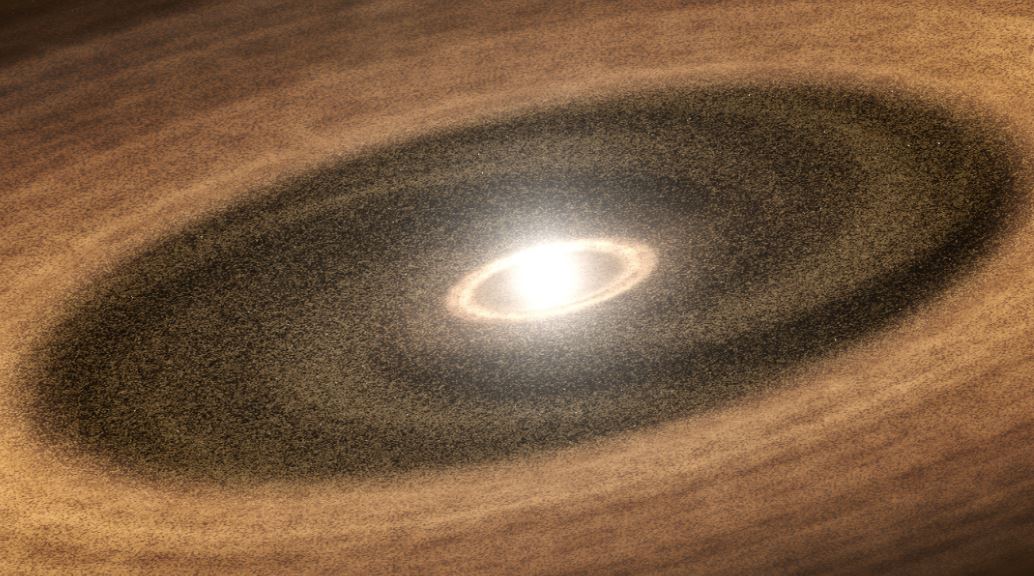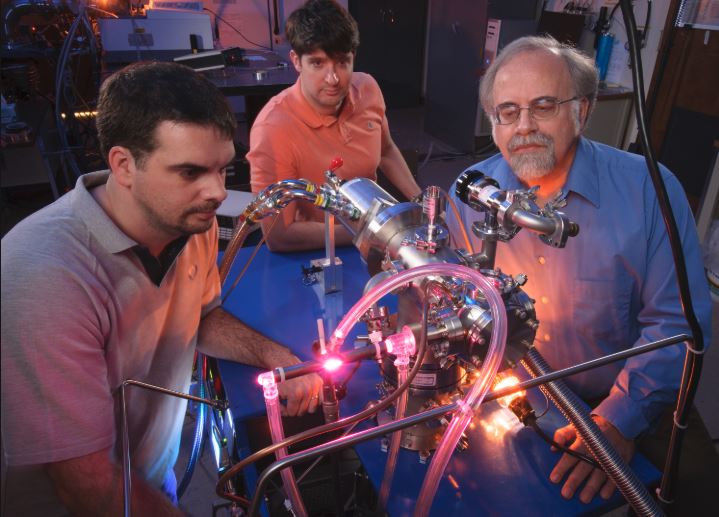

News
NASA lab confirms DNA sugar can be made in space, adding evidence that ‘life’ could be all over the universe
NASA researchers at the Ames’ Astrophysics and Astrochemistry Lab in Mountain View, California have provided the first experimental evidence demonstrating that the sugar in DNA – 2-deoxyribose – can be formed in interstellar space. In their study published on December 18, 2018 in the journal Nature Communications, Michel Nuevo, George Cooper, and Scott Sandford combined organic compounds, water vapor, and light – all elements present in interstellar space – inside a vacuum chamber mimicking the cosmic environment and observed the results. Along with the DNA sugar, a variety of other sugar derivatives were found to have been created. This discovery is more evidence that the chemical building blocks of life could be common all over the universe, seeding other planets as they did Earth in the ancient past.
One of the biggest questions science is constantly pursuing is whether we are alone in the universe, a research endeavor that takes many paths. Astrophysicist Carl Sagan is famously quoted often, saying, “The nitrogen in our DNA, the calcium in our teeth, the iron in our blood, the carbon in our apple pies were made in the interiors of collapsing stars. We are made of star stuff.” It meant that the universe is filled with the building blocks of life, thus the pursuit to find out how those building blocks combine to actually form life is an endeavor with the farthest reaching implications. Scott Sandford, one of the study’s researchers, added to this in reference to his own team’s experiment, saying, “The universe is an organic chemist. It has big beakers and lots of time – and the result is a lot of organic material, some of which is useful to life.”
To make their discovery, the Ames team cooled an aluminum substance to near absolute zero inside a vacuum chamber (since space is a vacuum), and added a mixture of water vapor and methanol gas before exposing it to ultraviolet light and heat, fully mimicking the interstellar environment. The space between stars is filled with dust and gases and is constantly subjected to light particles bombarding in from every radiation-emitting source around it. The experiment was designed to help answer the question of whether the space environment itself can make the compounds essential to life rather than just the single-elemental building blocks. Another team of researchers in France previously discovered the creation of ribose – the sugar in RNA, a possible precursor to DNA – in an experiment similar to the current study, setting the stage for the team’s further findings.

A growing number of organic compounds have been found on meteorites over the years including carbon, hydrogen, oxygen, nitrogen, and sulphur. Despite the actively changing geography of Earth complicating the discovery of remnants from its very early days, scientists have been able to find and study things like carbonaceous chondrites, meteorites originating from asteroids as old as our solar system. This research has made it possible to analyze how planets have formed and evolved over billions of years. Combining this type of research along with other work demonstrating that meteorites in general contain the building blocks of life and travel throughout the galaxies of the universe, the expanding number of exoplanets being found could imply even more significant possibilities.
Exoplanets, i.e., planets that orbit stars other than our own, are being discovered on a regular basis as data from prior and current observatory and telescope missions is reviewed. Over the last 20 years since “planet hunting” really got started, over 3800 exoplanets have been confirmed with around 2900 more awaiting confirmation. By observing the amount of light a distant star dims over period of time, scientists can determine whether there is a planet orbiting it, its size, distance from its star, and the colors missing in the planets’ atmosphere light spectrum which tell what chemicals are present, such as oxygen, carbon dioxide, nitrogen, and so forth. After analyzing all of these things, it can be predicted whether an exoplanet may be Earth-like and whether it’s in what’s called the “Goldilocks Zone”, or position where life as we know it might have the right conditions to evolve.
That may seem like a lot of conditions to meet, but it’s estimated that around 20-50 percent of the stars in our night sky may have small, rocky planets in their stars’ habitable zones. As more is learned about planet formation, that number may be revised up or down. Thus far, one planetary system has been studied extensively that has planets somewhat similar to Earth: TRAPPIST-1. It’s comprised of an ultra-cool dwarf star with 7 rocky worlds orbiting it, all of them potentially having water, some more than Earth. Considering the growing evidence that the seeds for life to evolve are prominently distributed and created throughout space with the number of potentially Earth-like planets being discovered, we may have some exciting news from the interstellar world in the near future.

Elon Musk
Elon Musk and Tesla AI Director share insights after empty driver seat Robotaxi rides
The executives’ unoccupied tests hint at the rapid progress of Tesla’s unsupervised Robotaxi efforts.

Tesla CEO Elon Musk and AI Director Ashok Elluswamy celebrated Christmas Eve by sharing personal experiences with Robotaxi vehicles that had no safety monitor or occupant in the driver’s seat. Musk described the system’s “perfect driving” around Austin, while Elluswamy posted video from the back seat, calling it “an amazing experience.”
The executives’ unoccupied tests hint at the rapid progress of Tesla’s unsupervised Robotaxi efforts.
Elon and Ashok’s firsthand Robotaxi insights
Prior to Musk and the Tesla AI Director’s posts, sightings of unmanned Teslas navigating public roads were widely shared on social media. One such vehicle was spotted in Austin, Texas, which Elon Musk acknowleged by stating that “Testing is underway with no occupants in the car.”
Based on his Christmas Eve post, Musk seemed to have tested an unmanned Tesla himself. “A Tesla with no safety monitor in the car and me sitting in the passenger seat took me all around Austin on Sunday with perfect driving,” Musk wrote in his post.
Elluswamy responded with a 2-minute video showing himself in the rear of an unmanned Tesla. The video featured the vehicle’s empty front seats, as well as its smooth handling through real-world traffic. He captioned his video with the words, “It’s an amazing experience!”
Towards Unsupervised operations
During an xAI Hackathon earlier this month, Elon Musk mentioned that Tesla owed be removing Safety Monitors from its Robotaxis in Austin in just three weeks. “Unsupervised is pretty much solved at this point. So there will be Tesla Robotaxis operating in Austin with no one in them. Not even anyone in the passenger seat in about three weeks,” he said. Musk echoed similar estimates at the 2025 Annual Shareholder Meeting and the Q3 2025 earnings call.
Considering the insights that were posted Musk and Elluswamy, it does appear that Tesla is working hard towards operating its Robotaxis with no safety monitors. This is quite impressive considering that the service was launched just earlier this year.
Elon Musk
Starlink passes 9 million active customers just weeks after hitting 8 million
The milestone highlights the accelerating growth of Starlink, which has now been adding over 20,000 new users per day.

SpaceX’s Starlink satellite internet service has continued its rapid global expansion, surpassing 9 million active customers just weeks after crossing the 8 million mark.
The milestone highlights the accelerating growth of Starlink, which has now been adding over 20,000 new users per day.
9 million customers
In a post on X, SpaceX stated that Starlink now serves over 9 million active users across 155 countries, territories, and markets. The company reached 8 million customers in early November, meaning it added roughly 1 million subscribers in under seven weeks, or about 21,275 new users on average per day.
“Starlink is connecting more than 9M active customers with high-speed internet across 155 countries, territories, and many other markets,” Starlink wrote in a post on its official X account. SpaceX President Gwynne Shotwell also celebrated the milestone on X. “A huge thank you to all of our customers and congrats to the Starlink team for such an incredible product,” she wrote.
That growth rate reflects both rising demand for broadband in underserved regions and Starlink’s expanding satellite constellation, which now includes more than 9,000 low-Earth-orbit satellites designed to deliver high-speed, low-latency internet worldwide.
Starlink’s momentum
Starlink’s momentum has been building up. SpaceX reported 4.6 million Starlink customers in December 2024, followed by 7 million by August 2025, and 8 million customers in November. Independent data also suggests Starlink usage is rising sharply, with Cloudflare reporting that global web traffic from Starlink users more than doubled in 2025, as noted in an Insider report.
Starlink’s momentum is increasingly tied to SpaceX’s broader financial outlook. Elon Musk has said the satellite network is “by far” the company’s largest revenue driver, and reports suggest SpaceX may be positioning itself for an initial public offering as soon as next year, with valuations estimated as high as $1.5 trillion. Musk has also suggested in the past that Starlink could have its own IPO in the future.
News
NVIDIA Director of Robotics: Tesla FSD v14 is the first AI to pass the “Physical Turing Test”
After testing FSD v14, Fan stated that his experience with FSD felt magical at first, but it soon started to feel like a routine.

NVIDIA Director of Robotics Jim Fan has praised Tesla’s Full Self-Driving (Supervised) v14 as the first AI to pass what he described as a “Physical Turing Test.”
After testing FSD v14, Fan stated that his experience with FSD felt magical at first, but it soon started to feel like a routine. And just like smartphones today, removing it now would “actively hurt.”
Jim Fan’s hands-on FSD v14 impressions
Fan, a leading researcher in embodied AI who is currently solving Physical AI at NVIDIA and spearheading the company’s Project GR00T initiative, noted that he actually was late to the Tesla game. He was, however, one of the first to try out FSD v14.
“I was very late to own a Tesla but among the earliest to try out FSD v14. It’s perhaps the first time I experience an AI that passes the Physical Turing Test: after a long day at work, you press a button, lay back, and couldn’t tell if a neural net or a human drove you home,” Fan wrote in a post on X.
Fan added: “Despite knowing exactly how robot learning works, I still find it magical watching the steering wheel turn by itself. First it feels surreal, next it becomes routine. Then, like the smartphone, taking it away actively hurts. This is how humanity gets rewired and glued to god-like technologies.”
The Physical Turing Test
The original Turing Test was conceived by Alan Turing in 1950, and it was aimed at determining if a machine could exhibit behavior that is equivalent to or indistinguishable from a human. By focusing on text-based conversations, the original Turing Test set a high bar for natural language processing and machine learning.
This test has been passed by today’s large language models. However, the capability to converse in a humanlike manner is a completely different challenge from performing real-world problem-solving or physical interactions. Thus, Fan introduced the Physical Turing Test, which challenges AI systems to demonstrate intelligence through physical actions.
Based on Fan’s comments, Tesla has demonstrated these intelligent physical actions with FSD v14. Elon Musk agreed with the NVIDIA executive, stating in a post on X that with FSD v14, “you can sense the sentience maturing.” Musk also praised Tesla AI, calling it the best “real-world AI” today.








